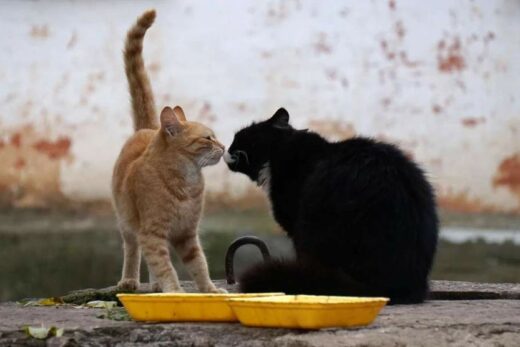
| Okay, we’re going to talk about kitty bathroom habits: pee and poop.
It’s a gross topic for some, but knowing what’s normal and what’s not can help you monitor your cat’s health. And with some conditions, like a urinary blockage, early detection is crucial to a positive outcome. |
#1 Cats & Pee
Quick Note About Hydration in Cats
Given that cats originated in desert areas where water is hard to come by, their bodies are used to getting moisture from prey instead of just water. That’s one of the reasons they aren’t the best water drinkers, and why you may not notice your cat drinking a ton of water.
If you feed your cat wet food, they will probably drink less water because wet food has a high moisture content.
How Often Do Cats Normally Pee?
Cats typically pee an average of twice a day, but this really depends on the individual.
Things like heat and humidity, water consumed, medications like steroids, and medical conditions like chronic kidney disease can increase the number of times a cat visits the box. On the flip side, stress and illness can be reasons a cat doesn’t visit the box as frequently.
This makes it important to try to track how frequently your cat is peeing because peeing less or more than their norm is a bigger sign of a problem than the actual number of times they go. For some cats, peeing four times a day is normal—but for another, that amount could be excessive. Reach out to your vet to talk about any change you see.
Also, visiting the box frequently and peeing only a little could indicate a urinary tract infection (UTI).
Straining and having no pee come out could indicate a serious medical condition like a urinary blockage (most common in male cats), and it will require immediate medical attention. When a cat is blocked, the toxins build up in their bodies and it’s fatal without treatment.
What Color Is Normal Cat Pee?
Typically, cat pee is pale yellow in color and clear. If you notice your cat’s pee is extremely yellow, cloudy, or has pink in it, you should talk to your vet.
Pink could indicate blood that comes from inflammation and UTIs. At the same time, completely pale urine means the urine is dilute, which is one of the main symptoms of chronic kidney disease (CKD).
What Does Normal Cat Pee Smell Like?
Fresh cat pee (I know, I know, ew) from a spayed or neutered cat is slightly acidic and really doesn’t have much of a smell. As time passes, bacteria in the pee give off an ammonia-like smell, and then the urine emits mercaptans, which are organosulfur modules that give off a skunk-like smell. This is why if your cat has an accident, it’s important to clean it up as soon as you notice it before these chemical changes happen.
Cats that have a stronger pee smell include:
- Unaltered cats, especially males, because their urine has high levels of testosterone in it to attract females and keep competing males away.
- Older cats with kidney issues.
- Dehydrated cats, because their pee has more waste in it than water, giving it an odor.
- Cat with UTIs. Sometimes the bacteria can make the pee smell.
Why Do Cats Pee Outside the Box?
This is the million-dollar question, and the truth is, there are lots of reasons.
Before we get into the types, make sure you’re using enzyme cleaner to clean up any accidents. It will eliminate the smell and help prevent your cat from going in the same spot again.
Now, let’s look at the two types of urination outside the box.





